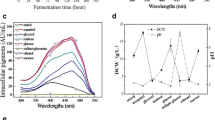Abstract
Pigments produced by species of Monascus have been used to coloring rice, meat, sauces, wines and beers in East Asian countries. Monascus can produce orange (precursor), yellow and red pigments. Orange pigments have low solubility in culture media and when react with amino groups they become red and largely soluble. The orange pigments are an alternative to industrial pigment production because the low solubility facilitates the downstream operations. The aim of this work was to study the kinetic on the production of orange pigments by Monascus ruber CCT 3802. The shaking frequency of 300 rpm was favorable to production, whereas higher shaking frequencies showed negative effect. Pigment production was partially associated with cell growth, the critical dissolved oxygen concentration was between 0.894 and 1.388 mgO2 L−1 at 30 °C, and limiting conditions of dissolved oxygen decreased the production of orange pigments. The maintenance coefficient (mo) and the conversion factor of oxygen in biomass (Yo) were 18.603 mgO2 g −1x h−1 and 3.133 gx gO −12 and the consideration of these parameters in the oxygen balance to estimate the biomass concentration provided good fits to the experimental data.







Similar content being viewed by others
References
Bridle P, Timberlake CF (1997) Anthocyanins as natural food colours-selected aspects. Food Chem 58:103–109
Sabater-Vilar M, Maas RFM, Fink-Gremmels J (1999) Mutagenicity of commercial Monascus fermentation products and the role of citrinin contamination. Mutat Res 444:7–16
Pennacchi MGC, Rodrígues-Fernández DE, Vendruscolo F, Maranho LT, Marc I, Cardoso LAC (2015) A comparison of cell disruption procedures for the recovery of intracellular carotenoids from Sporobolomyces ruberrimus H110. Int J Appl Biol Pharm 6:136–143
Dufossé L, Galaup P, Yaron A, Arad SM, Blanc P, Murthy KNC, Ravishankar G (2005) Microorganisms and microalgae as sources of pigments for food use: a scientific oddity or an industrial reality? Trends Food Sci Technol 16:389–406
Meinicke RM, Vendruscolo F, Moritz DE, Oliveira D, Ninow JL (2012) Potential use of glycerol as substrate for the production of red pigments by Monascus ruber in submerged fermentation. Biocatal Agric Biotechnol 1:238–242
Lu LP, Zhang BB, Xu GR (2013) Efficient conversion of high concentration of glycerol to Monacolin K by solid-state fermentation of Monascus purpureus using bagasse as carrier. Bioprocess and Biosyst Eng 36:293–299
Bühler RMM, Müller BL, Moritz DE, Vendruscolo F, Oliveira D, Ninow JL (2015) Influence of light intensity on growth and pigment production by Monascus ruber in submerged fermentation. Appl Biochem Biotechnol 10:1–13
Chen JC, Wang J, Wang ZJ, Li YJ, Pang J, Lin HT, Yin SW (2015) Effect of Monascus aged vinegar on isoflavone conversion in soy germ by soaking treatment. Food Chem 186:256–264
Vendruscolo F, Bühler RMM, Carvalho JC, Oliveira D, Moritz DE, Schmidell W, Ninow JL (2016) Monascus: a reality on the production and application. Rev Appl Biochem Biotechnol 178:211–223
Hsu FL, Wang PM, Lu SY, Wu WT (2002) A combined solid-state and submerged cultivation integrated with adsorptive product extraction for production of Monascus red pigments. Bioprocess Biosyst Eng 25:165–168
Meinicke RM, Dutra AC, Vendruscolo F, Moritz DE, Ninow JL (2013) Monascus pigment production in bioreactor using a co-product of biodiesel as substrate. Food Sci Technol 33:9–13
Mostafa ME, Abbady MS (2014) Secondary metabolites and bioactivity of the Monascus pigments review article. Glob J Biotechnol Biochem 9:1–13
Shao Y, Lei M, Mao Z, Zhou Y, Chen F (2014) Insights into Monascus biology at the genetic level. Appl Microbiol Biotechnol 98:3911–3922
Vendruscolo F, Tosin I, Giachini AJ, Schmidell W, Ninow JL (2014) Antimicrobial activity of Monascus pigments produced in submerged fermentation. J Food Proces Preserv 38:1860–1865
Hajjaj H, Blanc P, Groussac E, Uribelarrea JL, Goma G, Loubiere P (2000) Kinetics analysis of red pigment and citrinin production by Monascus ruber as a function of organic acid accumulation. Enz Microb Technol 27:619–625
Jung H, Kim C, Kim K, Shin CS (2003) Color characteristics of Monascus pigments derived by fermentation with various amino acids. J Agric Food Chem 51:1302–1306
Wong H, Koehler PE (1983) Production of red water-soluble Monascus pigments. J Food Sci 48:1200–1203
Lin TF, Yakushijin K, Buchi GH, Demaln AL (1992) Formation of water-soluble Monascus pigments by biological and semi-synthetic processes. J Ind Microbiol 9:173–179
Vendruscolo F, Schmidell W, Moritz DE, Bühler RMM, Oliveira D, Ninow JL (2016) Isoelectric point of amino acid: importance for monascus pigment production. Biocatal Agric Biotechnol 5:179–185
Vendruscolo F, Müller BL, Moritz DE, Oliveira D, Schmidell W, Ninow JL (2013) Thermal stability of natural pigments produced by Monascus ruber in submerged fermentation. Biocatal Agric Biotechnol 2:278–284
Miller GL (1959) Use of dinitrosalicilic acid reagent for determination of reducing sugar. Anal Chem 31:426–428
Vendruscolo F, Rossi MJ, Schmidell W, Ninow JL (2012) Determination of oxygen solubility in liquid media. ISRN Chem Eng 1:1–5
Schmidell W (2001) In: Schmidell W, Borzani W, Lima UA, Aquarone E (eds) Transferência de oxigênio em biorreatores, 2nd edn. Edgard Blücher, São Paulo
Luedeking R, Piret EL (1959) A kinetic study of the lactic acid fermentation. Batch process at controlled pH. J Biochem Microbiol Technol Eng 1:393–411
Pirt SJ (1975) Principles of microbe and cell cultivation. A halted press book. Willey, New York
Zabriskie DW, Humphrey AE (1978) Real-time estimation of aerobic batch fermentation biomass concentration by component balancing. AIChE J 24:138–146
Okafor N (2007) Modern industrial microbiology and biotechnology. Science Publishers, Enfield
Acknowledgments
The authors wish to thank the Conselho Nacional de Desenvolvimento Científico e Tecnológico (CNPq—The National Council for Scientific and Technological Development) for financial support (process number 476056/2006-3) and Coordenação de Aperfeiçoamento de Pessoal de Nível Superior (CAPES—Committee for Professional Development of Higher Education Staff) for a research scholarship.
Author information
Authors and Affiliations
Corresponding author
Ethics declarations
Conflict of interest
The authors declare that there is no conflict of interest.
Rights and permissions
About this article
Cite this article
Vendruscolo, F., Schmidell, W., de Oliveira, D. et al. Kinetic of orange pigment production from Monascus ruber on submerged fermentation. Bioprocess Biosyst Eng 40, 115–121 (2017). https://doi.org/10.1007/s00449-016-1679-5
Received:
Accepted:
Published:
Issue Date:
DOI: https://doi.org/10.1007/s00449-016-1679-5




